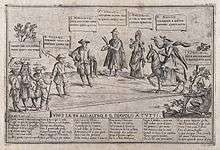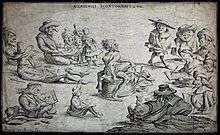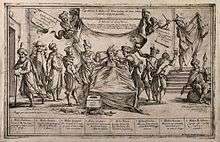Giuseppe Maria Mitelli
Giuseppe Maria Mitelli (1634–1718) was an Italian engraver and painter of the Baroque period. He was the son of the prominent quadratura painter Agostino Mitelli. The younger Mitelli was best known for his prolific engravings, in a great variety of subjects, including scenes from grand epics to mundane page boards for games of chance using dice, Tarot cards, and an Iconophor with anthropomorphized alphabets.[1] He also engraved genre subjects, allegories, moralistic scenes, but even some bizarre cartoons that could be interpreted as sometimes provocatively subversive, or presciently revolutionary, and sometimes imaginatively bizarre.[2] He often depicted dwarfs engaged in buffoonery or satirical depictions of aphorisms, which recalls the Bambocciate di nani or arte pigmeo of genre painter Faustino Bocchi (1659–1742).


Giuseppe studied or worked under Francesco Albani, Flaminio Torri, Guercino, and Simone Cantarini; he had a long career of over 60 years in Bologna. Mitelli was a flamboyant character who was also a painter and sculptor. He enjoyed a broad set of physical activities including fencing, hunting, fishing, tennis, gymnastics, and acting.
Engravings of Contemporary Trades
Giuseppe Maria produced a series of engravings depicting Arts of the Street, published in 1660.[3] This was part II of a book of engravings, in which part I, Diverse Figure, had been engraved by Simon Guillain II, and published in Bologna by Giovanni Atanasio Mosini. The inspiration for these works was either from Annibale Carracci’s drawings, or subsequent engravings by Simon Guillain II.[4]

The second part, titled The Arts of the Street (Di Bologna. L’Arti per Via) celebrates the tradesmen and workmen who practiced their occupations in the streets of Bologna.[6] A list of the engravings includes:
|
|
Other Images by Mitelli

He drew an enraged Imre Thököly in oriental garb behind bars (though it is unlikely that Mitelli would ever have seen the Hungarian rebel and Ottoman sympathiser as a prisoner in person).[8] The Ottoman menace was still alive for Christian in this era.
In another cartoon, he mocks the assistance that foreign Doctors provide to a dying Ottoman Sultan. The engraving contains the sultans hat under a commode, and a torn Koran. The dying sultan pleads to his parting Vizier to save his realm for Islam (see dying Sultan and doctors). This cartoon highlights the response of the European kingdoms in the signing of the Treaty of Karlowitz of 26 January, 1699.
He also drew a laborer destroying a classical female statue.[9] In 2010, an exhibition of 250 drawings and engravings were displayed in an exhibition titled Il mondo fantastico nelle incisioni di Giuseppe Maria Mitelli at the Galleria Garisenda (Strada Maggiore 14/a) of Bologna.[10]
References and Footnotes
- ↑ See a similar effort by Giovanni Battista Braccelli.
- ↑ Lombardia Beni Culturali.
- ↑ Italian Art at the Utah Museum of Art: a Guide to the Collection. Ursula M. Brinkman Pimentel, contribution by Madelyn D. Garrett. page 118-122.
- ↑ A pupil of both Alessandro Algardi and Ludovico Carracci, Simon Guillain II, was born in Paris, was the son of sculptor and engraver Simon of Cambrai (1581-1658).
- ↑ He who from pungent serpents and vipers,/ seeks to make the body anatomy whole,/ only exhibits that his sole true patent/ is the privilege of deceiving the world. or in Italian: Costui, che di angue, e vipere pungenti/ Vuol far de l'anatomico facondo,/ Sol mostra su l'autentiche patenti/ Il privilegio d'ingannare il Mondo.
- ↑ Also see engravings published by Gaetano Zompini.
- ↑ Engraving at Art Institute of Chicago.
- ↑ Morgan Library drawings: Imre Thököly imprisoned.
- ↑ Morgan Library drawings: Man Destroying a Statue with a Hammer.
- ↑ Repubblica newspaper of Bologna.